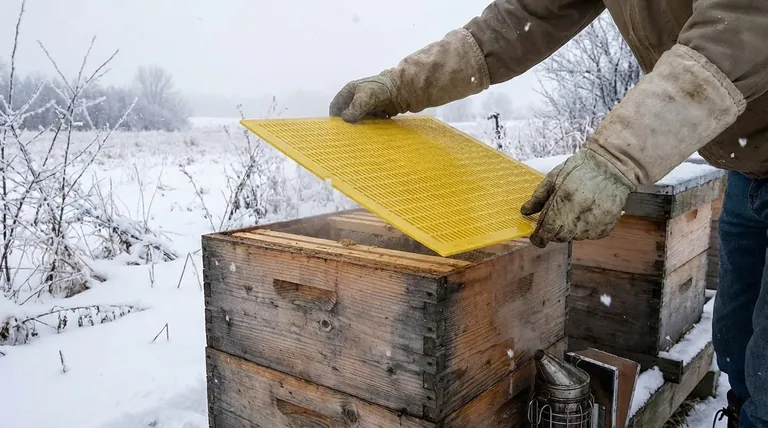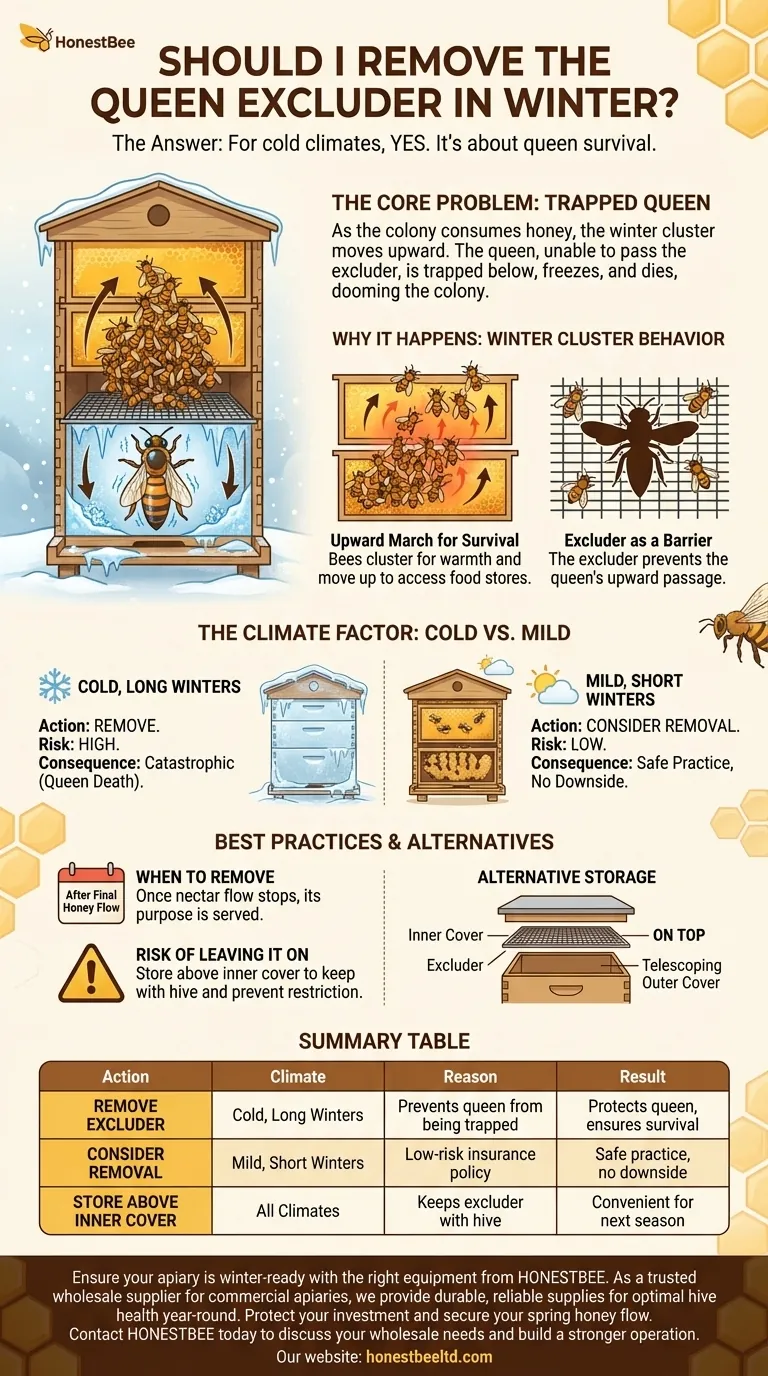For beekeepers in climates with cold winters, the answer is a definitive yes. You should remove the queen excluder after the final honey flow of the season. Leaving it in place creates a significant and often fatal risk to your queen and, by extension, the entire colony.
The core issue is not the excluder itself, but the natural behavior of a honey bee winter cluster. As the colony consumes its honey stores, it moves upward, and an excluder can trap the queen below this moving cluster, leading to her death and the ultimate collapse of the hive.

Why the Winter Cluster Changes Everything
To understand the need for removing the excluder, you must first understand how a honey bee colony survives the winter. It’s a process fundamentally at odds with the function of an excluder.
The Upward March for Survival
As temperatures drop, bees form a tight cluster to generate heat and maintain a survivable core temperature. The colony feeds on honey to fuel this process.
As they consume honey from a frame, they slowly and collectively move upward in the hive to access the next patch of honey stores above them. This slow, upward migration is essential for their survival.
The Queen Excluder as a Fatal Barrier
The queen excluder is designed to be a barrier that only worker bees can pass through. The queen, with her larger thorax, cannot.
If the winter cluster moves above the queen excluder, the queen is physically trapped below. She cannot follow the colony to the food and warmth.
The Result: A Queenless Colony
Separated from the heat and food of the cluster, the queen will inevitably freeze and die. Come spring, the beekeeper will discover a queenless colony that has no way to raise a new one, dooming it to failure.
The Critical Factor: Your Climate
While removing the excluder is a critical rule for some, it is less important for others. Your local climate is the deciding factor.
Cold, Long Winters
In any region where temperatures consistently drop below freezing for extended periods, removing the queen excluder is standard, necessary practice.
The risk of the cluster moving above the excluder is extremely high, and the consequence—the death of the queen—is catastrophic.
Mild, Short Winters
In subtropical or tropical climates where brood rearing continues year-round (albeit at a reduced rate), the need to remove the excluder is far less urgent.
In these conditions, the cluster may not need to make a significant upward migration, and the queen often remains integrated with the brood and the bees. However, removal is still a safe, no-cost insurance policy.
Understanding the Trade-offs and Best Practices
Making the right decision is about timing and understanding the risks versus the benefits of convenience.
When to Remove the Excluder
The ideal time to remove the queen excluder is after the last honey flow of the season is complete. Once the bees are no longer actively bringing in nectar to store in honey supers, the excluder has served its purpose for the year.
The Risk of Leaving It On
The primary risk is the one already stated: trapping and killing the queen. There is virtually no benefit to leaving the excluder in place during a cold winter that outweighs this severe risk.
An Alternative: Storing Above the Inner Cover
A practical management technique is to move the queen excluder and place it on top of the inner cover, directly beneath the telescoping outer cover.
This keeps the excluder with the hive, preventing it from being misplaced, while ensuring it does not restrict the colony's movement in any way.
Finalizing Your Winter Hive Configuration
Your decision should be guided by a simple assessment of your climate and goals for the colony's survival.
- If your primary focus is colony survival in a cold climate: Remove the queen excluder entirely or place it above the inner cover. This is non-negotiable.
- If your primary focus is managing a hive in a mild, frost-free climate: Removal is less critical but remains the safest practice with no downside.
- If your primary focus is efficiency and simple spring setup: Store the excluder above the inner cover so it is ready for the first nectar flow of the next season.
Properly preparing your hive for winter is the foundation for a strong and productive colony next spring.
Summary Table:
| Action | Climate | Reason | Result |
|---|---|---|---|
| Remove Excluder | Cold, long winters | Prevents queen from being trapped below the winter cluster | Protects queen, ensures colony survival |
| Consider Removal | Mild, short winters | Low-risk insurance policy | Safe practice with no downside |
| Store Above Inner Cover | All climates | Keeps excluder with hive for spring | Convenient setup for next season |
Ensure your apiary is winter-ready with the right equipment from HONESTBEE.
As a trusted wholesale supplier for commercial apiaries and beekeeping equipment distributors, we provide durable, reliable supplies designed for optimal hive health year-round. Protect your investment and secure your spring honey flow.
Contact HONESTBEE today to discuss your wholesale needs and build a stronger, more resilient operation.
Visual Guide

Related Products
- Professional Plastic Queen Excluder for Modern Beekeeping
- Wooden Queen Bee Excluder for Beekeeping
- High Performance Plastic Queen Excluder for Beekeeping and Apiary Management
- Premium Wood Framed Metal Wire Queen Bee Excluder
- Plastic Queen Bee Excluder for Bee Hive Wholesale
People Also Ask
- What are the pros of using queen excluders? Boost Honey Production & Hive Efficiency
- How does a queen excluder work? Master Hive Management for Pure Honey Harvests
- How do queen excluders work in terms of spacing and bee movement? A Guide to Precision Hive Management
- What is the purpose of a queen excluder when adding a super? Streamline Your Honey Harvest
- What are the pros of using a queen excluder? Boost Hive Control & Honey Quality



















